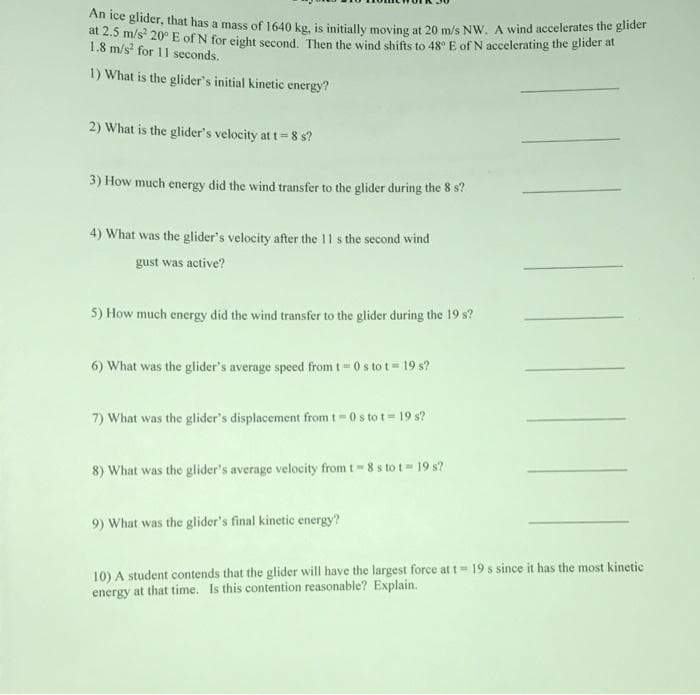ghder, that has a mass of 1640 kg, is initially moving at 20 m/s Nw. A wind accelerates the glider t 2.5 m/s 20° E of N for eight second. Then the wind shifts to 48° E of N accelerating the glider at 1.8 m/s for 11 seconds. 1) What is the glider's initial kinetic energy? 2) What is the glider's velocity at t= 8 s? 3) How much energy did the wind transfer to the glider during the 8 s? 4) What was the glider's velocity after the 11 s the second wind gust was active? 5) How much energy did the wind transfer to the glider during the 19 s? 6) What was the glider's average speed fromt = 0 s to t = 19 s? 7) What was the glider's displacement from t=0s to t= 19 s? 8) What was the glider's average velocity from t 8 s to t 19 s? 9) What was the glider's final kinetic energy? 10) A student contends that the glider will have the largest force at t= 19 s since it has the most kinetic energy at that time. Is this contention reasonable? Explain.
ghder, that has a mass of 1640 kg, is initially moving at 20 m/s Nw. A wind accelerates the glider t 2.5 m/s 20° E of N for eight second. Then the wind shifts to 48° E of N accelerating the glider at 1.8 m/s for 11 seconds. 1) What is the glider's initial kinetic energy? 2) What is the glider's velocity at t= 8 s? 3) How much energy did the wind transfer to the glider during the 8 s? 4) What was the glider's velocity after the 11 s the second wind gust was active? 5) How much energy did the wind transfer to the glider during the 19 s? 6) What was the glider's average speed fromt = 0 s to t = 19 s? 7) What was the glider's displacement from t=0s to t= 19 s? 8) What was the glider's average velocity from t 8 s to t 19 s? 9) What was the glider's final kinetic energy? 10) A student contends that the glider will have the largest force at t= 19 s since it has the most kinetic energy at that time. Is this contention reasonable? Explain.
Elements Of Electromagnetics
7th Edition
ISBN:9780190698614
Author:Sadiku, Matthew N. O.
Publisher:Sadiku, Matthew N. O.
ChapterMA: Math Assessment
Section: Chapter Questions
Problem 1.1MA
Related questions
Question
I need help solving 4 hrough 10

Transcribed Image Text:ghder, that has a mass of 1640 kg, is initially moving at 20 m/s Nw. A wind accelerates the glider
t 2.5 m/s 20° E of N for eight second. Then the wind shifts to 48° E of N accelerating the glider at
1.8 m/s for 11 seconds.
1) What is the glider's initial kinetic energy?
2) What is the glider's velocity at t= 8 s?
3) How much energy did the wind transfer to the glider during the 8 s?
4) What was the glider's velocity after the 11 s the second wind
gust was active?
5) How much energy did the wind transfer to the glider during the 19 s?
6) What was the glider's average speed fromt = 0 s to t = 19 s?
7) What was the glider's displacement from t=0s to t= 19 s?
8) What was the glider's average velocity from t 8 s to t 19 s?
9) What was the glider's final kinetic energy?
10) A student contends that the glider will have the largest force at t= 19 s since it has the most kinetic
energy at that time. Is this contention reasonable? Explain.
Expert Solution
This question has been solved!
Explore an expertly crafted, step-by-step solution for a thorough understanding of key concepts.
Step by step
Solved in 2 steps with 1 images

Knowledge Booster
Learn more about
Need a deep-dive on the concept behind this application? Look no further. Learn more about this topic, mechanical-engineering and related others by exploring similar questions and additional content below.Recommended textbooks for you

Elements Of Electromagnetics
Mechanical Engineering
ISBN:
9780190698614
Author:
Sadiku, Matthew N. O.
Publisher:
Oxford University Press

Mechanics of Materials (10th Edition)
Mechanical Engineering
ISBN:
9780134319650
Author:
Russell C. Hibbeler
Publisher:
PEARSON

Thermodynamics: An Engineering Approach
Mechanical Engineering
ISBN:
9781259822674
Author:
Yunus A. Cengel Dr., Michael A. Boles
Publisher:
McGraw-Hill Education

Elements Of Electromagnetics
Mechanical Engineering
ISBN:
9780190698614
Author:
Sadiku, Matthew N. O.
Publisher:
Oxford University Press

Mechanics of Materials (10th Edition)
Mechanical Engineering
ISBN:
9780134319650
Author:
Russell C. Hibbeler
Publisher:
PEARSON

Thermodynamics: An Engineering Approach
Mechanical Engineering
ISBN:
9781259822674
Author:
Yunus A. Cengel Dr., Michael A. Boles
Publisher:
McGraw-Hill Education

Control Systems Engineering
Mechanical Engineering
ISBN:
9781118170519
Author:
Norman S. Nise
Publisher:
WILEY

Mechanics of Materials (MindTap Course List)
Mechanical Engineering
ISBN:
9781337093347
Author:
Barry J. Goodno, James M. Gere
Publisher:
Cengage Learning

Engineering Mechanics: Statics
Mechanical Engineering
ISBN:
9781118807330
Author:
James L. Meriam, L. G. Kraige, J. N. Bolton
Publisher:
WILEY